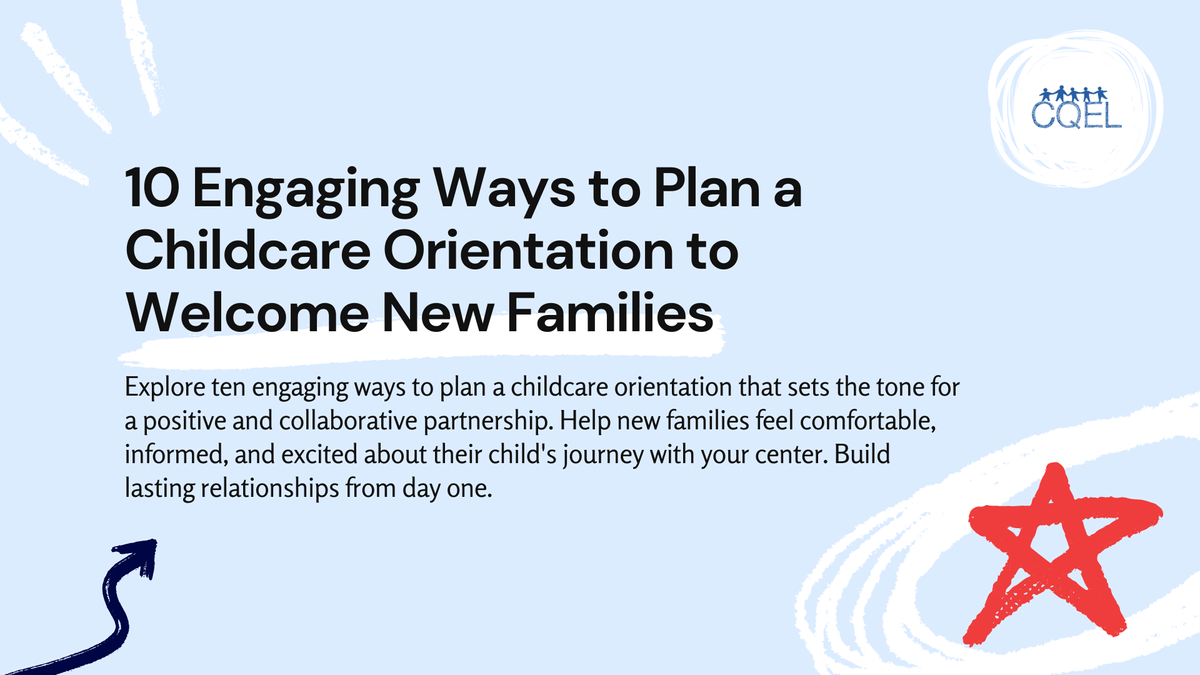10 Engaging Ways to Plan a Childcare Orientation to Welcome New Families
Learn how to create a welcoming and engaging orientation for new families at your childcare center. Discover ten effective strategies to build strong relationships and ensure a positive start. Make new families feel valued and excited about joining your community.

Welcoming new families to your childcare center is a crucial step in building a strong and trusting relationship. A well-planned orientation not only provides essential information but also sets the tone for a positive and collaborative partnership. By making the orientation engaging and informative, you can help new families feel comfortable, valued, and excited about their child's journey with your center. In this blog post, we will explore ten engaging ways to plan a childcare orientation that will leave a lasting impression on new families.
1. Personalize the Invitation
Begin the orientation process with a personalized invitation. Send a warm and welcoming email or letter to new families, addressing them by name and expressing your excitement about their upcoming enrollment. Include details about the orientation event, such as the date, time, location, and a brief overview of what to expect. Personalization shows that you value each family and sets a positive tone for the orientation. For inspiration on crafting personalized communication, consider resources like HubSpot's Guide to Email Personalization.
2. Create a Welcoming Atmosphere
Set the stage for a welcoming atmosphere by decorating the orientation space with colorful and inviting decorations. Use banners, balloons, and posters that reflect the values and mission of your childcare center. Arrange comfortable seating and provide refreshments to make families feel at ease. A warm and inviting environment helps new families feel more comfortable and engaged. Resources like Orientations and Open Houses: Creating a Welcoming Environment from NAEYC can provide additional ideas.
3. Provide a Comprehensive Welcome Packet
Prepare a comprehensive welcome packet for each family, including essential information about your childcare center. The packet should include:
- A welcome letter from the director
- An overview of your center's philosophy and mission
- Daily schedules and routines
- Staff biographies and contact information
- Policies and procedures
- Enrollment forms and required documentation
- A list of frequently asked questions (FAQs)
Providing this information upfront helps families feel informed and prepared. You can find templates and examples at Scholastic's Early Childhood Resources.
4. Use Interactive Presentations
Incorporate interactive presentations into your orientation to keep families engaged. Use multimedia tools such as slideshows, videos, and animations to present key information. Include photos and videos of daily activities, special events, and classroom environments to give families a glimpse of what their child will experience. Interactive presentations make the orientation more dynamic and memorable.
5. Offer Guided Tours
Conduct guided tours of your childcare center to familiarize families with the facilities. Show them the classrooms, playgrounds, restrooms, and common areas. Highlight key features such as safety measures, learning centers, and outdoor play spaces. Encourage families to ask questions and provide insights into how each area supports their child's development. Guided tours help families visualize their child's day-to-day experiences. For tips on organizing tours, refer to Early Childhood Center Tours: Best Practices.
6. Host Meet-and-Greet Sessions
Organize meet-and-greet sessions with the staff to help families get to know the educators who will be caring for their children. Allow time for informal conversations where families can ask questions and learn more about the staff's qualifications, teaching philosophies, and personal interests. Building personal connections with the staff fosters trust and confidence in your childcare center.
7. Include Interactive Activities
Incorporate interactive activities into the orientation to engage families and create a sense of community. Consider activities such as:
- Icebreaker games to help families get to know each other
- Hands-on demonstrations of classroom activities and learning materials
- Collaborative projects where families can work together on a fun task
Interactive activities make the orientation more enjoyable and help families feel more connected to the center and each other. For ideas on interactive activities, visit PBS Kids Activities.
8. Provide Opportunities for Q&A
Allocate time for a question-and-answer (Q&A) session where families can ask any questions they may have. Encourage open and honest communication, and provide clear and concise answers. Address common concerns such as safety protocols, communication methods, and curriculum details. A dedicated Q&A session ensures that families leave the orientation feeling informed and reassured.
9. Share Success Stories and Testimonials
Share success stories and testimonials from current families and alumni to highlight the positive impact of your childcare center. Include stories of children's achievements, parent experiences, and staff dedication. Real-life examples and testimonials build credibility and demonstrate the value of your program. Consider creating a video montage or a testimonial wall to showcase these stories. For guidance on gathering and presenting testimonials,.
10. Follow Up with a Warm Welcome
After the orientation, follow up with a warm welcome email or letter to thank families for attending and to reiterate your excitement about their enrollment. Include any additional information or resources they may need and provide contact information for any further questions. A thoughtful follow-up reinforces the positive experience and keeps the lines of communication open. For follow-up email templates and tips, consider a template for a follow-up mail strategy.
Planning an engaging childcare orientation is essential for building strong relationships with new families and setting the stage for a successful partnership. By personalizing the invitation, creating a welcoming atmosphere, using interactive presentations, offering guided tours, hosting meet-and-greet sessions, including interactive activities, providing opportunities for Q&A, sharing success stories, and following up with a warm welcome, you can create a memorable and impactful orientation experience. These strategies will help new families feel confident, informed, and excited about their child's journey with your center, ultimately contributing to a positive and collaborative relationship.
